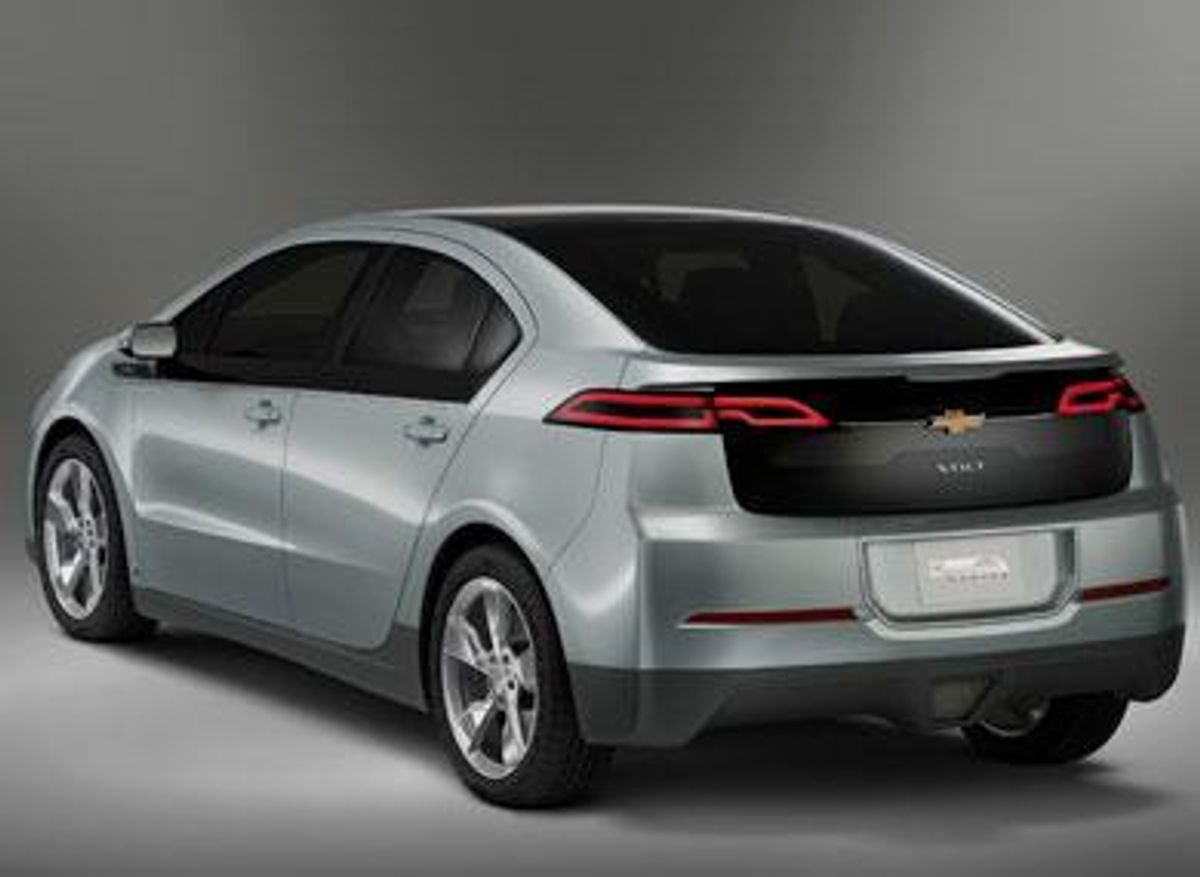Launching a new
vehicle while the American auto industry is asking
Congress for a $25 billion bailout might seem like illogical
timing, but for General Motors and the people behind
the Chevy Volt, it's essential. The Chevy Volt
is the first plug-in electric vehicle from the domestic
automaker, and GM is betting the bank on this one. The
success of this vehicle is "vital"
to the future of GM and to establish a
"leadership position" in electric propulsion
vehicles, says Volt vehicle line producer Tony
Posawatz. The Chevy Volt is without question an
amazing and innovative product, but are the hopes pinned on
its success too high to obtain?
With projected
production at about 10,000 the first year and a retail
cost of almost $40,000, no one is expecting the Volt to turn
the company around financially. Executives do hope,
however, that it will bring in people to purchase one
of the many new and fuel-efficient vehicles that GM
now has to offer. GM currently has nine hybrid models
available and over 3 million FlexFuel (able to run on
E85 ethanol) vehicles on the road. The Volt is a
public-relations darling used to get people into Chevy
showrooms, says Posawatz, but it's also a promise to
the public that "this is happening and not just
a shell game" -- a la the EV1, General Motors
attempt in the '90s to launch an electric vehicle,
which it killed when public interest proved lukewarm.
GM has been
working hard for the past decade to try and change public
perception of its products after a long period of producing
substandard cars and trucks with abysmal fuel economy
and lackluster build quality. It was a company
mandate, says Rob Peterson, manager of electric vehicle
technology communications -- not only to get the Chevy Volt
to the consumer as quickly as possible, but to emerge
"as a leader in alternative propulsion
vehicles."
In order to stir
interest and to show the public that it is serious about
electric vehicles, alternative propulsion sources, and
environmentally responsible products, GM has had to
change the way it approaches the customer.
"We have
specifically targeted people who are early adopters of new
technology and those concerned about environmentally
conscious products," says Peterson.
Targeting LGBT
consumers is one way they are getting the word out.
Travis Parman,
LGBT media relations manager for General Motors, says that
"reintroducing members of the LGBT community to GM
brands and building brand loyalty" are
paramount to future success. According to data General
Motors used to brand marketing campaigns, the LGBT community
has a buying power of almost $700 billion dollars. On
average, LGBT people have higher disposable incomes
and spend more on their automobiles. And most
important, 82% of LGBT consumers purchase products or
services primarily from companies that have shown
support for them. With estimates ranging from 7% to
10% of all Americans identifying as lesbian, gay,
bisexual, or transgender, that's a large loyal fan
base -- one GM is determined to keep.
The Chevy Volt
itself won't hit the market until late 2010, so GM is
counting on the continued hype and specifically targeted PR
to keep interest afloat. Peterson says the way
companies advertise to people is changing.
"You have
to talk to the people who talk to the people," he
says. "Monthly publications and print media
can't keep up with the Internet. People
don't want to hear what some corporate press kit
says, they want to know from people like them what they
think."
One branch of
GM's public-relations department deals specifically with
diversity outreach -- and gays are the only minority
being actively targeted.
"Members
of the LGBT community tend to be early adopters of new
technology," Peterson says, "[and] they seem
to be more open to change and ingenuity in
general."
Saab, Saturn, and
Cadillac have advertised in gay publications starting
as early as 1993. Over the last 24 months, Parman says, GM
has been aggressively and actively pursuing LGBT
consumers. Special events like Gay Day at the L.A.
Auto Show are designed to bring members of the
community together as well as showcase GM products. General
Motors is also a big supporter of Motor City Pride in
Detroit as well as Affirmations, a Detroit LGBT group.
Parman, who is gay, understands the brand recognition
and loyalty that comes from placing a rainbow flag next
to your product. The idea is that by showing support for
LGBT people, we will in turn show support for GM and
the Volt.
The Chevy Volt is
mainly targeted toward urban and affluent areas where
the thought of spending $40,000 on a four-seat hatchback
isn't such a bizarre idea, especially if it
meets consumer needs for environmental friendliness
and boasts the latest in cool technology. The interior is
designed to look like the sleek and modern iPod, with a
not-so-subtle nod to the people who can afford to buy
such things. It is a tougher sale in Middle America,
however, where some still think global warming is a hoax
and that they might strike oil in their own back yard.
"Trends
begin in the West and move inward," Peterson says.
He, a Midwestern farmboy, understands the skepticism
and aversion to newness that plague his fellow
neighbors, but hopes that with education and targeted
advertising they will eventually come around.
With a range of
40 miles on just a single charge of the lithium ion
battery -- 75% of the U.S. population commutes 40 miles or
less in urban and suburban areas, according to GM --
there are some drivers who wouldn't have
to put gasoline in their Chevy Volts at all. After the
battery's charge has been spent, it can go another
100 miles using the onboard gasoline engine. But
unlike hybrid cars, the gasoline engine never directly
powers the vehicle. Instead, the engine is used to
recharge the battery, which is the only means of driving the
car.
Peterson
admits that perceptions have to change fast in order
for GM to remain viable. That's why they have
been "wide open" about the Volt and its
ongoing development.
As for what lies
ahead for the U.S. auto industry, many of the folks at
GM try to avoid the question, or have been trained to voice
the corporate rhetoric that their future, with the
help of the government, can be bright and that
products such as the Volt are going to be America's
saving grace. Some seem less convinced. For now, GM is
hoping the Chevy Volt will be a "game
changer" and a goodwill gesture that will
indicate to the buying public that GM is serious about
the changing needs of the automotive consumer and is
prepared to be a leader in fuel-efficient,
environmentally responsible products.
GM CEO Rick
Wagoner said at the Senate hearings about the requested $25
billion bailout that the money would be used to further
develop products that consumers want -- such as
the Volt -- as well as pay off debts to suppliers
and take care of employee retirement and heath care
obligations. All the CEOs from the big-three automakers
admitted in the Senate hearings that they did indulge
out-of-control American spending and irresponsible
lending. They took advantage of the good times and
didn't plan for or envision a time less buoyant.
Those weighing in on the proceedings aren't so
sure that companies who couldn't make a profit in
good times will turn their luck around now that their backs
are against the wall.
With seven
different brands and 56 models, some say that the largest
auto manufacturer in America has gotten too big. Many
vehicles overlap one another in price, function, and
target audience. GM has dumped billions of dollars
into several different types of alternative propulsion
technologies such as electric, gas-electric hybrids,
cellulose, and bio fuels, all in the hopes of being at
the forefront when one of them really takes off.
"We're kind of hedging our bets on the next
big thing," says Peterson, so that when one or
more gets the green light from government or the public,
"we're ready."
-- The Chevy
Volt will be on display at the Los Angeles Auto
Show, which opens Friday, November 21. For more
information visitwww.LAAutoShow.com.


















































































